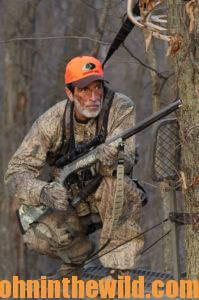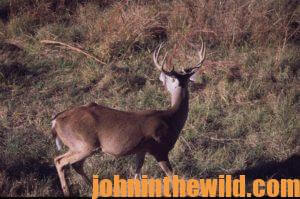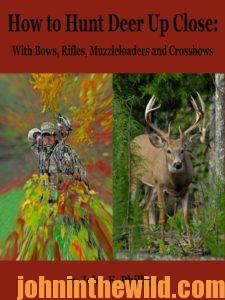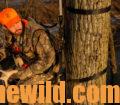Editor’s Note: When you first fall out of a tree and before you hit the ground, you have plenty of time to think about how stupid you’ve been, the mistakes you’ve made, and what you should have done to prevent the beating you’re about to take. I know from firsthand experience. I’ve fallen from tree stands on four different occasions, although not in recent years. The bruises, scratches, scrapes and loss of breath finally have taught me how important learning tree-stand safety is and how to keep from falling when I climb.
Climbing tree stands are much-safer than tree steps and fixed stands because you are less exposed to danger. The climbing stands that surround the hunter in some type of metal cage are the  safest of all. However, you still must take safety precautions. When you fasten a climbing tree stand to the tree, you must realize that most trees are bell-shaped – larger at the bottom than they are at the top. When you attach the seat and the platform, make sure both parts of the stand are leaning into the tree slightly. The more tapered the tree is, the more you should have the tree stand leaning into the tree before you start your climb.
safest of all. However, you still must take safety precautions. When you fasten a climbing tree stand to the tree, you must realize that most trees are bell-shaped – larger at the bottom than they are at the top. When you attach the seat and the platform, make sure both parts of the stand are leaning into the tree slightly. The more tapered the tree is, the more you should have the tree stand leaning into the tree before you start your climb.
Although when the words, “tree stand accidents,” are heard, most of us think of someone falling from a great height to the ground, but some accidents occur at less than three feet off the ground. A hunter may fall out of a climbing tree stand when he’s attaching the ropes or the bungee cords to his feet to enable him to pull the stand up as he climbs. When you’re standing up in a tree stand trying to attach foot straps, you’re in an awkward position. Falling can be easy. When you attach the straps to your feet, always be seated in the stand first to greatly reduce your chance for accidents.
But you can be safer by using a safety belt – even when you’re climbing with your tree stand. Statistics have proven that safety belts can prevent as many if not more accidents for hunters as seat belts do for drivers of automobiles. Before you start to climb the tree in a climbing tree stand, attach your safety belt to the tree. As you climb, slide the belt up the tree, and move the belt above you. Then you’re always secure to the tree from the time you leave the ground. Once you arrive at the desired height, either use the strap securing your feet to the bottom platform, or carry a piece of rope to tie the seat climber to the bottom platform. Then if the bottom half of the stand comes loose from the tree and falls, it can’t fall any further than the length of rope you have attached to it. Also this bottom platform can be retrieved easily to allow you to come down the tree safely. If and when you stand in the tree stand, make sure your safety belt is attached snugly. But to be the most-safe, wear a safety harness.
The Minnesota Department of Natural Resources gives these safety tips for hunters using climbing tree stands:
* Attach a safety strap to the tree to prevent you from falling, more than 12 inches.
* Realize in the event of a fall, harnesses provide some cushion, generally about 4 inches, which is the result of the alternately tightening and slipping of the harness as well as the normal stretch of the material.
* Always inspect the safety harness for signs of wear or damage before each use.
* Follow all manufacturers’ instructions for use of a safety harness and stand.
* Always use a haul line to pull up your gear and unloaded firearms or bow to your tree stand. Never climb with anything in your hands or on your back. Before descending, lower your equipment on the opposite side of the tree.
* Always select the proper tree for use with your tree stand. Select a live, straight tree that fits within the size limits recommended in your tree stand’s instructions.
* Always hunt with a plan, and if possible, with a buddy. Let others know your exact hunting location, when you plan to return, and with whom you’re hunting.
 * Carry emergency signal devices, such as a cell phone, whistle, walkie-talkie, signal flare and flashlight on your person at all times and within reach, even when you’re suspended in your tree stand.
* Carry emergency signal devices, such as a cell phone, whistle, walkie-talkie, signal flare and flashlight on your person at all times and within reach, even when you’re suspended in your tree stand.
* Don’t climb higher than 10 feet above the ground.
* Know your physical limitations. Don’t take chances. If you start thinking about how high you are, don’t go any higher.
* Make slow, even movements of no more than 10 – 12 inches at a time while climbing with a tree stand. Have proper contact with the tree and/or tree stand every time you move.
To learn more about hunting deer, check out John E. Phillips’ book, available in Kindle, print and Audible versions, “How to Hunt Deer Up Close: With Bows, Rifles, Muzzleloaders and Crossbows” (http://amzn.to/11dJRu8).
Tomorrow: Why Deer Hunters Like Ladder Stands and Safety Harnesses 










